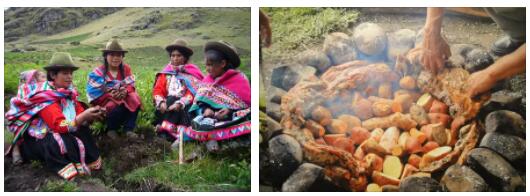What do you eat in Peru?
Beans, pumpkins, peanuts, corn, avocados and potatoes have been grown in the area of today’s Peru for many centuries. Even back then, the Indians kept guinea pigs to eat. There was fishing on the coasts. These old traditions have been preserved, plus the Spanish influences from the colonial era. The Spaniards brought wheat, rice and onions to South America, for example, but also numerous recipes for stews.
The potato comes from Peru
It can no longer be clarified whether the potato originally came from Peru or from Chile. However, it has been proven that the potato was found in the wild in the Peruvian Andes several millennia ago. Countless varieties are still grown today. It is estimated that 3000 varieties of potato grow in Peru!
What is Pachamanca?
A very old dish is pachamanca. Ingredients are pieces of meat of several kinds (for example lamb, guinea pig and pork) as well as potatoes and other root vegetables such as sweet potatoes or cassava, as well as beans. All ingredients are wrapped in a corn leaf. These packets then cook in an earth oven. To build it, stones are heated in the fire and stacked to form a pyramid, in the middle of which the food comes. Then earth comes around and the whole thing cooks in it. The preparation is therefore complex and is mainly used for banquets.
A Peruvian specialty: guinea pigs
Guinea pigs were discovered a long time ago by the Indians as a tasty food. It’s like chicken for us. The Cuy, as it is called here, is eaten prefer grilled or fried. Seasoned, fried in a pan and weighted down with a stone, the preparation is called cuy chactado. It is usually served whole, with the head. This is served with potatoes and beans and there is a sauce called salsa criolla.
Do you know…?
Some ingredients from the Peruvian coast are unknown in Europe. Or have you heard of Olluco before? Peruvians like to eat their tubers with dried meat (charqui), for example from lama or beef. The maca and yacón plants also produce edible tubers.
Quinoa is grown in the Andes. The mustard seed-sized seeds can be used like grain. Cherimoya, on the other hand, like Lúcuma and Cocona, is a fruit that looks strange but tastes delicious.
Drinks: Chicha and Inca Kola
A popular drink among Peruvian children is Chicha morada (pronounced: Chitscha morada). It is made from a specific purple variety of corn (maíz morada). The corn is boiled in water for about an hour until the water is purple. Peel from pineapples and apples are added to the water. It is seasoned with cinnamon, sugar and lemon juice are added. It is served cool and with apple pieces in it.
The Peruvian children like cola too. But there is a very special variety here: the Inca Kola. It is drunk more than Coca-Cola in Peru. Incidentally, Inca Kola is yellowish. It gets its typical taste from the lemon bush.
And what else is there to eat?
Typical Peruvian dishes are:
- Ceviche: raw fish is pickled in lemon juice. There are also onions, corn, sweet potatoes and rocoto strips. Rocoto is a hot pepper variety.
- Rocoto relleno: And you like to fill this pepper, that’s Rocoto relleno. The filling consists of minced meat and cheese.
- Pollo a la Brasa: This is grilled chicken. In the past it was mostly cooked in embers (brasa), today it is more likely to be found on a rotisserie. Along with ceviche, it is one of the most popular dishes in Peru. The chicken is usually served with french fries and a salad.
- Arroz con Pollo: rice with chicken. There can also be potatoes, for example papas a la Huancaína. These are potatoes in a creamy cheese sauce that are also often served as a starter.
- Tacacho: Green plantains are fried and mashed. You mix that with pork or cheese. In Ecuador the dish is called “Bolón de Verde”.
- Locro: Locro is a soup made from potatoes, pumpkin and beans. It has its origin with the indigenous peoples and there are different local variants.
- Lomo saltado: pieces of beef are placed in soy sauce and fried with peppers and onions. There are also fries and rice. Soy sauce and rice are ingredients that Chinese immigrants once brought to Peru. The Chinese-influenced cuisine even has its own name in Peru, namely Chifa. Lomo saltado is easy to cook and there are homemade fries.
Seasoning: chilli and annato
Chili peppers are probably the most important spice in Peruvian cuisine. They add heat to many dishes. Garlic and annato, which give dishes a yellow color, are also popular.
